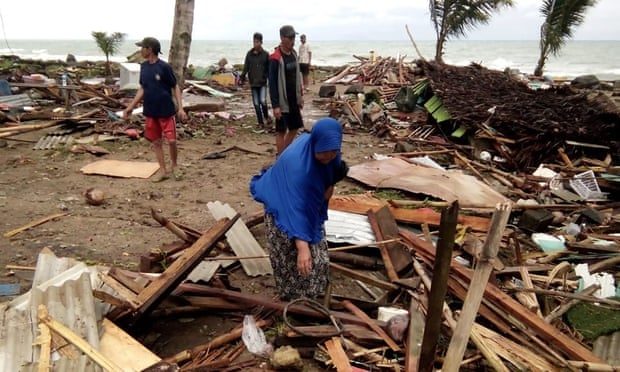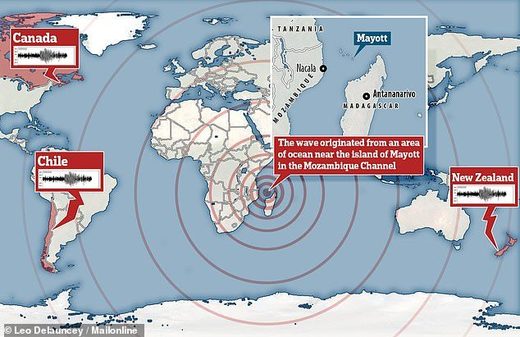
The waves were apparently triggered by a combination of underwater landslides caused by the eruption of Mount Krakatoa and an abnormal tidal surge due to a new moon, Sutopo Purwo Nugroho, the national disaster agency spokesman, said.
He said dozens of buildings were destroyed by the wave, which hit beaches in South Sumatra and the western tip of Java about 9.30 pm local time on Saturday.
Mr Nugroho later said the death toll had risen to 168, with 745 injured and 30 missing. "This number will continue to rise considering not all places have been checked," he added.
Endan Permana, head of the agency in Pandeglang, told Metro TV police were providing immediate assistance to victims in Tanjung Lesung in Banten province, a popular tourist getaway not far from the capital, Jakarta, as emergency workers had not arrived in the area yet.
"Many are missing," Permana said.
Waves wash away band during concert
Among those killed were at least two members of local rock band Seventeen, who were performing under a tent on a beach as dozens of people sat listening at tables covered in white cloths.
The tragedy was captured on camera. As bright strobe lights flashed on stage, a child could be seen wandering through the crowd.
Then, in between songs with the drummer pounding, the stage suddenly heaved forward, throwing the band and all their equipment into the audience.
The band released a statement saying their bass player and road manager were found dead, while four other members of their group remained missing.
"The tide rose to the surface and dragged all the people on site," it said. "Unfortunately, when the current receded our members are unable to save themselves while some did not find a place to hold on."
Riefian Fajarsyah, lead vocalist of the band, later posted an emotional video to his 260,000 Instagram followers in which he said the group's bassist and road manager were killed.
Fighting back tears and wiping his eyes, Fajarsyah said two more band members, a crew member and his wife were still missing.
"We lost our bassist Bani and our road manager Oki," he said in the video, in which he is wearing a green shirt with the band's Seventeen logo stitched into the chest.
"Andi (drummer) and Herman (guitar) and Ujang (crew) have not been found. Please pray so that my wife Dylan (Dylan Sahara) will be found soon.
The disaster agency said it was still compiling information and there was a "possibility that data on the victims and damage will increase".
Indonesia's geological agency was investigating the cause, Mr Nugroho said, adding the death toll would likely increase.
Mr Nugroho posted footage on social media of the moment the waves hit, with water rushing in and local residents trying to flee in panic.
He also shared a video of the aftermath of the tsunami, with flooded streets and an overturned car.
Anak Krakatoa is a small volcanic island that emerged from the ocean half a century after Krakatoa's deadly 1883 eruption, which is estimated to have killed more than 36,000 people.
Tourists told to stay away from region's beaches over Christmas
Authorities warned residents and tourists in coastal areas around the Sunda Strait to stay away from beaches and a high-tide warning remained in place through till December 25.
"Please do not be around the beaches around the Sunda Strait. Those who have evacuated, please do not return yet," said Rahmat Triyono, head of the meteorological agency.
One tourist, Oystein Lund Anderson, said he was taking photos of the legendary volcano when the tsunami hit on Saturday night.
"I had to run, as the wave passed the beach and landed 15-20m inland," he wrote on Facebook.
"Next wave entered the hotel area where I was staying and drowned cars on the road behind it. Managed to evacuate with my family to higher ground trough forest paths and villages, where we are taken care of my the locals. Were unharmed, thankfully."
"So encountered my first tsunami it seems, hopefully my last," Mr Anderson wrote.
The worst affected area was the Pandeglang region of Banten province in Java, which encompasses the Ujung Kulon National Park and popular beaches, the disaster agency said. Of the deaths, 33 were in Pandeglang.
In the city of Bandar Lampung on southern Sumatra, hundreds of residents took refuge at the governor's office.
Alif, a resident in Pandeglang district who goes by one name, said the tsunami reached about 3 meters (9.84 feet) high. He told MetroTV station that many people were still searching for missing relatives.
'I just prayed and ran'
The Anak Krakatau volcano in the Sunda Strait that links the Indian Ocean and Java Sea erupted about 24 minutes before the tsunami, the geophysics agency said.
At Carita beach, a popular day-tripping spot on the west coast of Java, 15-year-old Muhammad Bintang described a sudden surge of water that plunged the tourist spot into darkness.
"We arrived at 9 pm for our holiday and suddenly the water came - it went dark, the electricity is off," he told AFP.
"It's messy outside and we still cannot access the road."
In Lampung province, on the other side of the strait, Lutfi Al Rasyid said he fled the beach in Kalianda city in fear for his life.
"I could not start my motorbike so I left it and I ran... I just prayed and ran as far as I could," the 23 year old told AFP.
Coastal residents reported not seeing or feeling any warning signs, like receding water or an earthquake, before waves of up to two metres washed ashore, according to media.
Although relatively rare, submarine volcanic eruptions can cause tsunamis due to the sudden displacement of water or slope failure, according to the International Tsunami Information Centre.
Gegar Prasetya, co-founder of the Tsunami Research Centre Indonesia, said the waves were likely caused by a flank collapse - when a big section of a volcano's slope gives way. He said it's possible for an eruption to trigger a landslide above ground or beneath the ocean, both capable of producing a tsunami.
"Actually, the tsunami was not really big, only one meter," said Prasetya, who has closely studied Krakatau. "The problem is people always tend to build everything close to the shoreline."
Ben van der Pluijm, an earthquake geologist and a professor in the University of Michigan, also said the tsunami may have been caused by a "partial collapse" of Krakatau.
"Instability of the slope of an active volcano can create a rock slide that moves a large volume of water, creating local tsunami waves that can be very powerful. This is like suddenly dropping a bag of sand in a tub filled with water," he said.
The 1,000-foot -high volcano, one of 127 active volcanoes which run the length of the archipelago, has been erupting since June. In July, authorities widened its no-go areas to 1.24 miles from the crater.
The deadly history of Krakatoa
When Krakatoa erupted in the 19th century, a jet of ash, stones and smoke shot more than 12 miles into the sky, plunging the region into darkness, and sparking a huge tsunami that was felt around the world.
The force of the eruption reportedly created the loudest noise ever recorded, with some of the explosions apparently heard 2,800 miles away in Pert, Australia.
Shock waves travelled around the world seven times and the force of the blast was some 10,000 times greater than that of the hydrogen bomb dropped on Hiroshima.
On Friday, the country's geologic agency said the volcano erupted for more than two minutes, creating an ash cloud that soared 400 metres above the mountain.
Indonesia, one of the most disaster-prone nations on earth, straddles the so-called Pacific 'Ring of Fire', where tectonic plates collide and a large portion of the world's volcanic eruptions and earthquakes occur.
The country regularly experiences deadly earthquakes. In September, at least 832 people were killed by a quake and tsunami that hit the city of Palu on the island of Sulawesi, which is just east of Borneo.




Comment:
UPDATE: On Dec. 24th the Guardian reports: Drone footage shows damage caused by Indonesian tsunami:
The BBC reports: Update: Zero Hedge reports death toll has climbed to 373, 1,400 Wounded: From the Daily Mail: UPDATE: On Dec. 26th CNN reports: